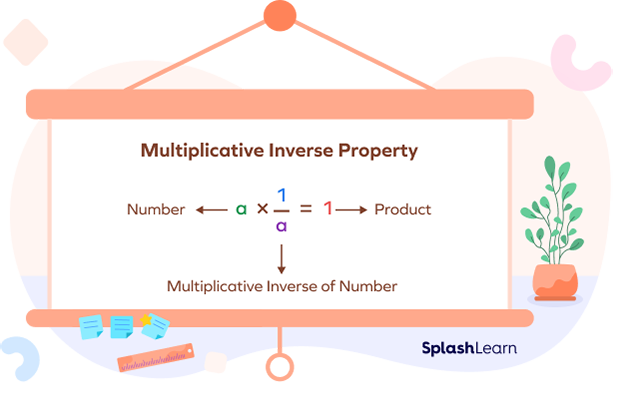What Is Multiplicative Inverse?
The meaning of the word “inverse” is something opposite in effect. The multiplicative inverse of a number is a number that, when multiplied by the given number, gives 1 as the product. By multiplicative inverse definition, it is the reciprocal of a number.
The multiplicative inverse of a number “a” is represented as a-1 or $\frac{1}{a}$.
 Begin here
Begin here
Multiplicative Inverse Property
The multiplicative inverse property states that if we multiply a number with its reciprocal, the product is always equal to 1. The image given below shows that $\frac{1}{a}$ is the reciprocal of the number “a”.

A pair of numbers, when multiplied to give product 1, are said to be multiplicative inverses of each other. Here, a and $\frac{1}{a}$ are reciprocals of each other.
Related Worksheets
How to Find the Multiplicative Inverse?
Consider that we have seven apples. To make them into groups of 1 each, we need to divide them by 7. Since division is the reverse process of multiplication, dividing by a number is equivalent to multiplying by the reciprocal of the number.
Thus, 7 ÷ 7 = 7 × $\frac{1}{7}$ = 1
Here, $\frac{1}{7}$ is called the multiplicative inverse of 7.
Let us understand the multiplicative inverse of different types of numbers like natural numbers, integers and fractions.
Natural Numbers
The numbers that are used for counting, such as 1, 2, 3, and so on, are known as natural numbers. The reciprocal of “a” is $\frac{1}{a}$.
For example, if we multiply 7 by $\frac{1}{7}$, we get $7\frac{1}{7}=1$. So, the multiplicative inverse of 7 is $\frac{1}{7}$.
Integers
The reciprocal of a positive integer “a” is $\frac{1}{a}$. Negative integers lie on the left side of zero on a number line and their value is always less than 0. Negative integers have minus (-) sign in front of them. The product of any integer and its reciprocal must be 1. The reciprocal of a negative number will be a negative number. For example: If the number is -2, then its reciprocal will be $-\frac{1}{2}$ not $\frac{1}{2}$, as $-2 \times \left[-\frac{1}{2}\right] = 1$
Fractions
To find the reciprocal of a fraction we can just flip it over. The reciprocal of any fraction $\frac{a}{b}$ is $\frac{b}{a}$, because $\frac{a}{b}\times\frac{b}{a}=1$.
Unit Fractions
Unit fraction is the fraction in which the numerator is 1 irrespective of the number in the denominator. The reciprocal of unit fraction $\frac{1}{x}$ is x, a whole number. For example, reciprocal or multiplicative inverse of ¼ is 4.
Mixed Fraction
A mixed fraction is a combination of a whole number and a proper fraction. For example: $2\frac{3}{7},5\frac{4}{5}$, etc.
In order to find the reciprocal of a mixed fraction, we convert it to an improper fraction and then find its reciprocal.
For example, to find the reciprocal of $2\frac{3}{7}$, we convert $2\frac{3}{7}$ to improper fraction, that is $\frac{17}{7}$.
Since the reciprocal of $2\frac{3}{7}$ or $\frac{17}{7}$ is $\frac{7}{17}$.
Fun Facts
- The word “reciprocal” comes from the Latin word “reciprocus”, which means back and forth.
- The multiplicative inverse of a proper fraction is an improper fraction.
Conclusion
In this article, we learned about the reciprocal of different types of numbers. To read more such informative articles on other concepts, do visit our website. We, at SplashLearn, are on a mission to make learning fun and interactive for all students.
Solved Examples on Multiplicative Inverse
Example 1: What is the multiplicative inverse of -100?
Solution: The multiplicative inverse of -100 is -$\frac{1}{100}$.
Example 2: The reciprocal of a number is $2\frac{3}{5}$. Find the number.
Solution: A pair of numbers when multiplied to give product as 1, they are said to be reciprocals of each other.
So, the reciprocal of $2\frac{3}{5}$ or $\frac{13}{5}$ is the original number. Since the reciprocal of $\frac{13}{5}$ is $\frac{5}{13}$, the original number is $\frac{5}{13}$.
Example 3: What is the multiplicative inverse of $\frac{2}{3} + \frac{3}{2}$?
Solution: To find the reciprocal, we need to simplify the expression first.
$\frac{2}{3} + \frac{3}{2} = \frac{13}{6}$The reciprocal of $\frac{13}{6}$ is $\frac{6}{13}$.
Practice Problems on Multiplicative Inverse
Multiplicative Inverse - Definition with Examples
Which of the following will be the multiplicative inverse of $\frac{1}{10}$?
The reciprocal of $\frac{1}{10}$ is 10.
The multiplicative inverse of a mixed fraction is a:
Mixed fractions can be converted into improper fractions. Since the reciprocal of an improper fraction is a proper fraction, the multiplicative inverse of a mixed fraction is a proper fraction.
Which number does not have a multiplicative inverse?
The multiplicative inverse of 0 is $\frac{1}{0}$, which is not defined.
Frequently Asked Questions on Multiplicative Inverse
What is the difference between multiplicative and additive inverse?
Additive inverse of a number is the number that, when added to the original number, gives 0 as the result. For example: Additive inverse of 5 is -5. On the other hand, the multiplicative inverse of a number is the number that, when multiplied by the original number, gives 1 as the result. For example: Multiplicative inverse of 5 is $\frac{1}{5}$.
What is the multiplicative inverse of 0?
As per the definition of multiplicative inverse of a number is a number that, when multiplied by the given number, yields the product as 1. Since the product of any number with zero is always zero. So we can say that zero doesn’t have a reciprocal.
Since division by zero is not defined, the reciprocal of zero, which is 1/0, is undefined. So, it does not exist.
What is multiplicative identity?
The multiplicative identity is a number, which when multiplied to any number “a”, gives a product as “a”. Multiplicative identity is a real number is 1, because $a\times1=a$
What is the use of multiplicative inverse?
The multiplicative inverse is used to simplify the expressions. One application of multiplicative inverse is when we solve the division problems. While dividing two numbers, we multiply the reciprocal of the divisor to the dividend. For example, 5 ÷ 10 = 5 × $\frac{1}{10} = \frac{1}{2}$.





















